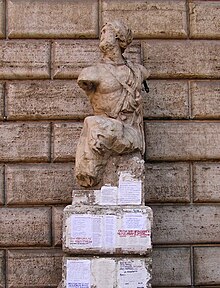Pasquill
The or the pasquill (Italian: "little pasquino", also: the pasquinade ) is an insult or derision that is written to slander a certain person or to hurt their honor. A pictorial representation that serves these goals can also be called Pasquill. The Pasquillant , the author of this publication, publishes anonymously or chooses a pseudonym .
In the early modern period , when the terms leaflet and pamphlet did not yet exist, these were also referred to as pasquill when they were supposed to influence opinions through a tendentious representation.
Origin of the term
The name Pasquill is said to be derived from a tailor named Pasquino who lived in Rome in the 16th century . He used to attach sharp satirical and reviling epigrams to a statue in his neighborhood , which was soon followed by poets, including Pietro Aretino , students and professors. The mocking verses on the statue called Pasquino were called Pasquinata or Pasquill .
The statue is a torso that represents Menelaus with the corpse of Patroclus . It is a Roman copy of a Greek group of figures from the ancient Roman stadium of Domitian , which was located on the site of today's Piazza Navona and which was found during excavations at the end of the 15th century. In 1501 the torso was erected in front of the neighboring Palazzo Braschi . On another of the Roman "speaking statues", the Marforio , replies to the diatribes attached to the Pasquino were often attached. The two statues sometimes had a downright dialogue about the pieces of paper attached to them.
The pasquill in literary history
One of the most famous diatribes in ancient literary history is the Apocolocyntosis by Seneca the Younger . The title literally means "gourd", in our language something like "kidding" of the emperor Claudius . In this satire in Menippe style , Seneca makes fun of the life, death and apotheosis of Claudius, who banished him to the island of Corsica in AD 41.
The obscene Pasquill Doktor Bahrdt with the iron forehead or the German union against Zimmermann had far-reaching consequences - not foreseen by the author . A play [...] by Knigge , which August von Kotzebue wrote under the pseudonym "von Knigge" in 1790. The occasion was the literary feud between Johann Georg Zimmermann and Karl Friedrich Bahrdt . Kotzebue took a stand on Zimmermann's side; his opponent he attacked with his writing in a sharp and very derogatory form. Initially, it was assumed that Zimmermann himself wrote the script and thus turned against the authors and publishers Joachim Heinrich Campe , Heinrich Christian Boie , Georg Christoph Lichtenberg , the Berlin enlighteners Friedrich Nicolai , Friedrich Gedike and Johann Erich Biester, Adolph von Knigge and others would have. This typeface cost Zimmermann his reputation, although August von Kotzebue later admitted that the Pasquill came from him. In the scandal that followed, the literary critics accused Kotzebue of immorality, and although his dramatic works were very popular at the time, they were hardly noticed by the critics.
See also
literature
- Günter Schmidt: Libelli Famosi. On the significance of the diatribes, scolding letters, disgraceful paintings and pasquille in German legal history. Diss.iur., Cologne 1985.
- Oswald Bauer: Pasquille in the Fugger newspapers. Poems of derision and abuse between polemics and criticism (1568–1605) (= source editions of the Institute for Austrian Historical Research. Volume 1). Böhlau u. a., Vienna 2008, ISBN 978-3-486-58554-4
- Christian Kuhn: Ballads, libels, and songs. In: Albrecht Classen (Ed.): The Handbook of Medieval Studies. Terms - Methods - Trends. Volume 2. de Gruyter, Berlin / New York 2010, ISBN 978-3-11-018409-9 , pp. 1618-1633.
- Pasquill . In: Heidelberg Academy of Sciences (Hrsg.): German legal dictionary . tape 10 , issue 3/4 (edited by Heino Speer and others). Hermann Böhlaus successor, Weimar 1998, ISBN 3-7400-0985-3 ( adw.uni-heidelberg.de ).
- References for the use of the word Pasquill from the 16th to the 18th century from the German legal dictionary
- A pasquill from the age of 30. War. Communicated by Oscar Schade . In: Weimar Yearbook for German Language, Literature and Art . Hannover 1855, pp. 66-76; archive.org
